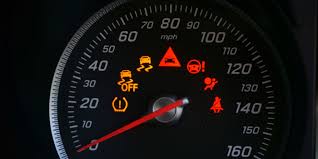Blog
The Role of TPMS in Autonomous Vehicles
The Role of TPMS in Autonomous Vehicles
As the automotive industry continues to evolve, one of the most exciting developments is the rise of autonomous vehicles (AVs). These self-driving cars are set to revolutionize the way we travel, offering safer, more efficient, and more accessible transportation. However, as with all cutting-edge technologies, ensuring the safety and reliability of autonomous vehicles requires the integration of advanced systems to monitor and maintain vehicle health. One such system is the Tire Pressure Monitoring System (TPMS), which plays a crucial role in the safe operation of autonomous vehicles.
In this article, we’ll explore the role of TPMS in autonomous vehicles, why it is essential, and how it integrates with other technologies to ensure smooth, safe, and efficient operation.
What is TPMS and Why Does It Matter for Autonomous Vehicles?
A Tire Pressure Monitoring System (TPMS) is a safety feature that continually monitors the air pressure within a vehicle’s tires. The system alerts the driver (or autonomous vehicle system) when tire pressure is too low or too high, helping prevent issues like tire blowouts, uneven wear, and poor fuel efficiency.
In traditional vehicles, TPMS is a passive system that primarily alerts the driver to a potential problem, allowing them to take action before an issue becomes dangerous. However, the role of TPMS in autonomous vehicles extends beyond merely alerting the system to tire issues. Since AVs are designed to operate without human intervention, it is crucial that the vehicle’s sensors and systems constantly monitor tire health and ensure all components are functioning optimally.
How TPMS Contributes to Autonomous Vehicle Safety
1. Real-Time Data for Safe Navigation
In autonomous vehicles, real-time data from sensors is vital for safe navigation. TPMS plays a key role in this by continuously sending updates on tire pressure and temperature. Since tire condition directly affects how a vehicle handles the road, maintaining accurate tire data helps AVs make better decisions, particularly in situations where handling, stability, or safety are at risk.
For example, if one tire is underinflated, it can affect the steering, braking, and stability of the vehicle, all of which are crucial factors for AVs when navigating complex road conditions. Real-time tire pressure monitoring ensures that the vehicle’s control systems can adjust in response to any tire-related issues, keeping the vehicle on track and preventing potential accidents.
2. Enhanced Stability and Control
Tire pressure is a significant factor in a vehicle’s stability and handling. In an autonomous vehicle, maintaining stable tire pressure is crucial for maintaining accurate control over the vehicle, especially when driving at high speeds or navigating through sharp turns. TPMS ensures that tires are kept within optimal pressure ranges, allowing the vehicle’s automated systems to make precise adjustments in real time.
For instance, if tire pressure becomes uneven across different wheels, it can lead to asymmetric handling or loss of traction. Autonomous vehicles rely heavily on balanced tire pressure to ensure smooth, predictable handling. TPMS helps ensure that each tire is properly inflated, which in turn ensures that the vehicle can follow its programmed path without unexpected behavior.
3. Predictive Maintenance and Proactive Issue Prevention
One of the major advantages of TPMS in autonomous vehicles is its ability to provide predictive insights. Traditional vehicles might rely on a driver to notice when the tire pressure is low and then take action. However, AVs operate without a human driver, which means that tire pressure data must be constantly monitored by the vehicle’s diagnostic systems.
Modern TPMS systems integrated with autonomous vehicles can go beyond simple alerts. Predictive maintenance capabilities can forecast potential issues before they occur by analyzing historical data, including tire pressure trends, temperature changes, and overall tire wear. For example, if a sensor detects that one tire’s pressure consistently fluctuates over time, it could predict an impending issue like a slow leak, enabling the vehicle to adjust its route to a nearby service station or suggest a proactive tire replacement.
Integration of TPMS with Other Autonomous Vehicle Systems
Autonomous vehicles rely on multiple integrated systems to navigate, make decisions, and ensure passenger safety. TPMS works in tandem with these systems to enhance vehicle performance. Let’s take a look at how TPMS interacts with other technologies in AVs:
1. Vehicle Control Systems
Autonomous vehicles use advanced control systems to adjust speed, direction, and braking in response to road conditions. TPMS contributes to this by ensuring that tire pressure remains consistent, preventing abnormal tire wear or instability that could compromise the vehicle’s handling. When tire pressure is monitored, AVs can more effectively adjust their speed and steering to maintain optimal stability and safety.
2. Road Condition Recognition
Autonomous vehicles use sensors such as LiDAR, radar, and cameras to detect road conditions and objects in their environment. TPMS data complements this by helping the vehicle’s system understand how tire health might influence its ability to interact with the road. For instance, in cold weather, underinflated tires might not perform as well on slick roads, leading to a higher risk of skidding. TPMS provides this crucial insight, allowing the AV to adjust its driving strategy accordingly.
3. Automated Tire Repair Systems
Some futuristic autonomous vehicles are equipped with automated repair systems that can take action to fix a tire issue without requiring human intervention. TPMS can serve as an integral part of this technology, providing real-time tire data to detect when a tire is losing air or showing signs of damage. In some cases, the vehicle might even have the capability to automatically seal a small puncture or deploy an inflating system to return the tire to its optimal pressure, all with no human involvement.

The Future of TPMS in Autonomous Vehicles
As autonomous vehicle technology advances, the role of TPMS will continue to evolve. Here are some exciting possibilities for the future:
1. Smart Tires with Embedded Sensors
The next generation of tires may have embedded sensors that not only monitor tire pressure but also track tire temperature, tread depth, and tire wear. These smart tires could provide even more comprehensive data to AVs, helping them optimize driving performance based on real-time tire health. This technology could also provide long-term data analytics that allow autonomous vehicles to predict and prevent tire failures well in advance.
2. Cloud-Based Tire Monitoring
As autonomous vehicles become more connected, cloud-based TPMS systems could allow for remote tire monitoring. Data from individual vehicles could be uploaded to the cloud, enabling fleet operators, manufacturers, or service centers to track tire health for entire fleets of autonomous vehicles. This could result in improved predictive maintenance and better coordination of tire replacement and repair schedules.
3. Integration with Autonomous Fleet Management
In a future with large fleets of autonomous vehicles, TPMS will be crucial for fleet management. With fleets of self-driving vehicles on the road, fleet operators can use TPMS to monitor the tire health of all vehicles remotely. This data could be used to optimize tire rotations, maintenance schedules, and even automate the ordering of replacements, helping companies maximize fleet uptime and reduce operational costs.
Conclusion
TPMS is not just a useful feature for traditional vehicles but a critical component for the safe and efficient operation of autonomous vehicles. By providing real-time tire health data, enhancing vehicle stability, supporting predictive maintenance, and integrating seamlessly with other systems, TPMS ensures that autonomous vehicles remain reliable and safe on the road. As autonomous technology continues to progress, the role of TPMS will grow even more significant, helping to shape the future of transportation and vehicle performance.



